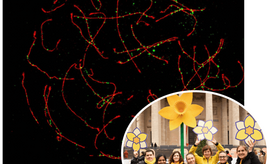A genome-wide association study identifies susceptibility loci for primary central nervous system lymphoma at 6p25.3 and 3p22.1: a LOC Network study
AbstractBackgroundPrimary central nervous system lymphoma (PCNSL) is a rare form of extra-nodal non-Hodgkin lymphoma. PCNSL is a distinct subtype of non-Hodgkin lymphoma, with over 95% of tumors belonging to the diffuse large B-cell lymphoma (DLBCL) group. We have conducted a genome-wide association study (GWAS) on immunocompetent patients to address the possibility that common genetic variants influence the risk of developing PCNSL.MethodsWe performed a meta-analysis of 2 new GWASs of PCNSL totaling 475 cases and 1134 controls of European ancestry. To increase genomic resolution, we imputed >10 million single nucleotide polymorphisms using the 1000 Genomes Project combined with UK10K as reference. In addition we performed a transcription factor binding disruption analysis and investigated the patterns of local chromatin by Capture Hi-C data.ResultsWe identified independent risk loci at 3p22.1 (rs41289586, ANO10, P = 2.17 × 10−8) and 6p25.3 near EXOC2 (rs116446171, P = 1.95 x 10−13). In contrast, the lack of an association between rs41289586 and DLBCL suggests distinct germline predisposition to PCNSL and DLBCL. We found looping chromatin interactions between noncoding regions at 6p25.3 (rs11646171) with the IRF4 promoter and at 8q24.21 (rs13254990) with the MYC promoter, both genes with strong relevance to B-cell tumorigenesis.ConclusionTo our knowledge this is the first study providing insight into the genetic predisposition to PCNSL. Our findings represent an important step in defining the contribution of common genetic variation to the risk of developing PCNSL.

